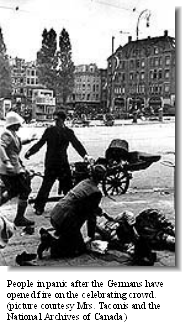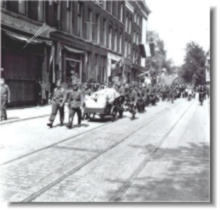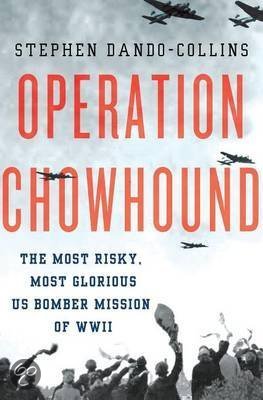The german surrender
 Not all Germans readily accepted the German surrender. On May 7 fanatic SS-soldiers opened fire on the celebrating Dutch citizens that had gathered in front of the Palace on the Dam in Amsterdam. Twenty-two civilians were killed and sixty were wounded in this terrible incident. This incident occurred on the same moment as the first British and Canadian elements entered the capital of Holland. After the German SS-ers and the Dutch Interior forces had exchanged fire, the resistance called the help in of the newly arrived liberators. After negotiations the Germans were persuaded to seize fire and come out of their headquarters. The airmen of the RAF and USAAF had no knowledge of this incident. The incident does illustrate that it is not unlikely that the whole food drop operation could have ended in a disaster. If these fanatics could show up fully armed in the middle of the liberation feast they could also have manned the anti-aircraft guns on the first day of the missions. Luckily this was not the case.
Not all Germans readily accepted the German surrender. On May 7 fanatic SS-soldiers opened fire on the celebrating Dutch citizens that had gathered in front of the Palace on the Dam in Amsterdam. Twenty-two civilians were killed and sixty were wounded in this terrible incident. This incident occurred on the same moment as the first British and Canadian elements entered the capital of Holland. After the German SS-ers and the Dutch Interior forces had exchanged fire, the resistance called the help in of the newly arrived liberators. After negotiations the Germans were persuaded to seize fire and come out of their headquarters. The airmen of the RAF and USAAF had no knowledge of this incident. The incident does illustrate that it is not unlikely that the whole food drop operation could have ended in a disaster. If these fanatics could show up fully armed in the middle of the liberation feast they could also have manned the anti-aircraft guns on the first day of the missions. Luckily this was not the case.
A piece of cake
The RAF and USAAF High command both did not consider the Chowhound- and Manna missions as combat missions and didn't give the crews credit for flying them. All the bombers had been on operational stand-down, for more than a week when the missions began and that status wasn't changed. That the first missions were not at all milk runs, is discussed in the previous chapters. The missions that followed were of course nothing like the dangers of the combat missions, but neither milk runs. We saw in Bob Upcott's account that there were still a number of fanatic nazi's in Holland that had no respect for the truce. Filled with hatred towards the allied, they fired on the slow and low flying bombers with small arms. Bob Upcott's story is no exception. Luckily did this enemy fire do little damage to the bombers, apart from one sad incident. On May 7, two days after the German surrender in occupied Holland, was a B-17 of the 95th BG hit by flak from the coast battery at IJmuiden. One engine got fire and the bomber crashed in flames into the North Sea. Rescue aircrafts of coastal command were quickly directed to the place of the crash, but this couldn't change the fact that all but two crewmembers lost their lives in this incident.*
 A group of bombers from the 385th was also fired upon by flak, on one of their Chowhound missions. The flak caused some damage, but all the bombers could return without casualties. John Wagner (96th BG) also remembers being greeted by flak on his first food drop mission. His pilot aborted the mission and the crew returned without damage. The following day the crew flew another mission and that time dropped their food without problems.
A group of bombers from the 385th was also fired upon by flak, on one of their Chowhound missions. The flak caused some damage, but all the bombers could return without casualties. John Wagner (96th BG) also remembers being greeted by flak on his first food drop mission. His pilot aborted the mission and the crew returned without damage. The following day the crew flew another mission and that time dropped their food without problems.
One bomber of the RAF was lost on one of the food drop missions. The pilot of this Lancaster led his flight engineer do the takeoff which led too a crash on the runway.
One image that many veterans of the Chowhound missions still have clear in their mind is the sight of the poor state that the otherwise fertile country was in. Norman Coats saw the Dutch standing on broken dikes. Claude Hall saw the effect of the broken dikes, when he saw a town that had been flooded. He could still see the church tower. Anyone who thought that the situation in Holland wasn't as bad as they had said in the briefing quickly changed his mind on this sight.
The sight however that all veterans remember most clearly, when they think back on the missions, is the sight of happy faces. They saw people cheering and people waving flags. These sights bring a smile on the faces of the old men, even after fifty-five years.
It was up to the crew chiefs how many men they took with them on these missions. For many crew chiefs this was an invitation to allow ground personnel with them. There didn't seem to be one policy within a Bomb Group. Bernie Behrman for instance mentions that he took several "observers" on different Chowhound missions, while Bob Belgam and Ralph DiSpirito tells that bringing ground personnel on the missions never came up as a possibility. Belgam did take ground personnel on tours over Europe after the war.
The mercy-flights certainly saved the lives of a number of Dutch civilians and definitely enlightened the hearts of all the other Dutch civilians who witnessed the drops. These drops reassured them that they were not forgotten and enforced the feeling that liberation was at hand.
For the Allied Air force personnel who participated in the operation, the missions have also been very important. After numerous flights in which death and destruction was delivered by them, they now for once had a different cargo. They were delivering the means to live instead of death from above. It seems to me that flying these missions must have helped them in handling the traumatic experiences that they underwent during the rest of the war.
* In later years some questions have risen if the bomber had indeed been hit by flak. A mechanical failure might have caused the engine to get on fire. One way or another the tragedy remains for those who lost their lives at the closing of the war.
 Author: Hans Onderwater This book by Hans Onderwater is the standard work about the food drop missions over Occupied Holland with a bundle of information, photos and first hand accounts of the hunger winter and the food drop missions.
Author: Hans Onderwater This book by Hans Onderwater is the standard work about the food drop missions over Occupied Holland with a bundle of information, photos and first hand accounts of the hunger winter and the food drop missions.